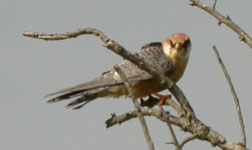|
|
|
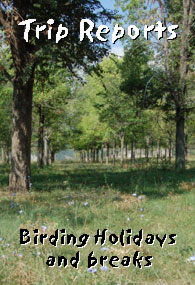 |
|
|
Site Details:

|
|
|
|
|
|
TRIP REPORTS:
|
|
|
Trip reports from participants of Catalan Bird Tours' 'Birdbox' - residential Birding Holidays and Breaks in Catalonia - will be posted here.
Trip reports from all seven sites are contained on this page.
|
|
|
|
|
|
|
|
|
|
|
|
|
|
|
|
|
|
|
|
|
|
|
|
|
For birding Day Tours Trip Reports:
|
|
|
|
|
|
|
|
|
|
|
|
|
|
|
|
|
|
|
|
|
|
|
|
|
|
|
|
|
|
|
|
|
|
|
|
Date
|
|
Author
|
|
Clients
|
|
|
Sites
|
|
|
|
|
|
|
|
|
|
|
|
|
|
|
|
|
|
|
|
|
|
|
|
|
|
|
|
|
|
|
|
|
|
|
|
|
|
|
|
|
|
|
|
|
|
|
|
|
|
28/ 29 October 2006
|
|
Jamie Simmons
|
|
Jamie Simmons, U.S.
|
|
|
PYR / STE / LLO / GAR
|
|
|
|
|
|
|
|
|
|
|
|
|
|
|
|
|
|
|
|
|
Given a surprise business trip to Barcelona, an internet appeal resulted in a recommendation to contact Stephen Christopher and, after bouncing late night emails between us, he recommended four locations over two days.
28th October 2006, Llobregat Delta and The Pyrenees
A riverside walk on the approach to the Llobregat reserve produced several warblers (Cetti’s, Fan-tailed, Sardinian, Blackcap, Chiffchaff) and finches (Chaffinch, Goldfinch, Serin) but an early bonus was a close sighting of Common Waxbill, a population that has apparently expanded over the last few decades from a handful of escaped birds.
A Green Woodpecker undulated away and, finally tempted by the hawking of mid-distant Marsh Harriers, we entered the main complex where the lagoons and reed beds were teeming with birds. The bulk were Coot and ducks (inc. Teal, Wigeon and Pintail) and the sprawl of Grey Heron were interrupted by the white of Cattle, Little and Great White Egrets and several Black-headed Gulls.
Lapwing formed by far the majority of the shorebird group with hundreds settled on the muddy ground but a more careful scan along the water’s edge showed that Spotted Redshank, Greenshank and Green and Common Sandpipers were also present. A Purple Swamphen or two scoured the same boundary, though always close to cover and a Kingfisher, viewed as a turquoise jewel zooming off from nearby shelter, was the highlight before we headed off to higher ground.
We arrived in the Pyrenees to discover Chaffinches everywhere and, from above a forested bank, we picked out many Coal Tit, got great views of Crested Tit and watched a Short-toed Treecreeper scuttle between the trunks and twigs of the pine trees. These pines produce cones all year round providing food for the Common Crossbill, which were evident as we made our way to a cliff-side meadow complete with natural spring and amazing view of the whole valley. From here Griffon Vulture filled the skies and almost the full set of corvids (inc. Carrion Crow, Raven and Alpine Chough) showed up at some point. Yet another, the Red-billed Chough, numbered around a hundred and escorted us as we headed up to a large meadow above the tree line.
Here we presided over the to-ing and fro-ing of many Blackbirds and Ring Ouzel. Song Thrush and Mistle Thrush, as well as at least one Redwing, were amongst them to cap a list that already included Sparrowhawk, Goldcrest, Blue Tit, Black Redstart, Woodlark, Meadow Pipit, Greenfinch and Northern Wheatear.
29th October 2006, The Steppes and The Garraf Massif
A dozen Pin-tailed Sandgrouse flew over as we arrived in Los Monegros but our attempts to track them as they circled unfortunately ended in failure. However, we were kept busy by a host of lark species – Calandra, Crested, Thekla and Skylarks – before we found a piece of fallow ground that looked likely.
A single incoming Black-bellied Sandgrouse alerted us to the presence of at least a dozen others and we moved forward, step by step, until we had excellent views. Once an oncoming tractor inspired their departure we ventured further into the vast area of fields picking up more raptors, a majestic Red Kite, a first winter Golden Eagle and a pair of Merlin hunting larks capping off an impressive bunch.
An incredibly vivid Whinchat, with its orangey breast standing out in the mid-day sun, was perhaps the pick of the passerines, which also included Linnet, Stonechat and Meadow Pipit. An extremely accommodating Little Owl sunned itself near a ruined house and a roadside Jay put in a brief appearance, as did Southern Grey Shrike and a ghostly male Hen Harrier, en route to the next location.
A brief stop-off in the Steppes of Lleida added Red-legged Partridge, White Stork and a secretive Cirl Bunting accidentally presenting itself through a gap in the foliage but then we headed off to the mountain range south of Barcelona called the Garraf Massif.
A Blue Rock Thrush flew over the car as we skirted a quarry heading deeper into the heart of the park itself, where we found, flitting about the edges of some small vineyards, Rock Bunting, Crested Tit and a group of noisy Long-tailed Tit shadowing each other along a row of trees and bushes. Equally noisy were a flock of Woodlark finding bush top perches in the fading light and along a forest-farmland boundary, the late activity showed up many passerines including Robin.
At our final stop, a coastal location adjacent to the village of Garraf itself, dozens of Crag Martin skimmed the cliff face, and each other, before gradually settling down to roost. Great Tit and Sardinian Warbler scuttled about trying to grab a late evening meal amongst the under growth as did White Wagtail, though they preferred to glean the morsels washed up along the stoney beach.
A series of straggling Yellow-legged Gulls trailed off over the ocean, lazily heading towards an unknown roost and we took our cue, called it a day and did likewise.
|
|
|
|
|
|
Black-bellied Sandgrouse
|
|
Llobregat Delta
|
|
Common Sandpiper
|
|
|
|
|
|
|
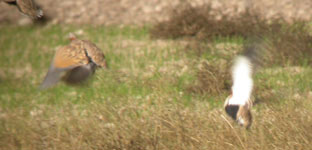 |
|
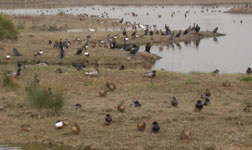 |
|
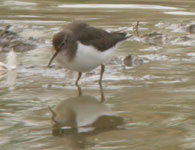 |
|
|
|
For a complete check list of this tour

|
|
|
|
|
|
|
|
|
|
|
|
|
|
|
|
|
|
|
|
|
|
|
|
|
|
|
|
|
|
|
|
|
|
|
|
|
|
|
|
|
|
|
|
|
|
|
|
|
|
|
10 - 13 September 2006
|
|
Stewart Abbott
|
|
Stewart Abbott, England
|
|
|
EBR / PYR / STE / LLO / GAR
|
|
|
|
|
|
|
|
|
|
|
|
|
|
|
|
|
|
|
|
|
|
|
"I will definitely return soon to Stephen’s home for another wonderful trip and can thoroughly recommend both him and Catalan Bird Tours without hesitation."
Approaching my 40th birthday I was offered a golfing trip from my family but the more I thought the more I fancied something different and then remembered how much I enjoyed the peace and calm of bird watching as a boy.
After deciding on Spain I checked out a few birding breaks and came across the perfect solution, a personal bird guide with accommodation in a self-contained apartment at the guide’s villa.
This meant we could get away nice and early and enjoy the non-birding moments drinking a beer by the swimming pool, playing pool and chatting with Stephen or even just sitting and watching the crested tits on the feeders.
Stephen, the guide, was very enthusiastic and extremely knowledgeable about the birds we saw and the places we visited. A fantastic picnic lunch was provided in beautiful surroundings and a great number of birds I had only ever dreamt of seeing were added to my list. My main objective was to relax so we didn’t bird all the time but we saw well over 100 species.
After my 3-day break was over I was completely relaxed (we even had time to see Barcelona play in the Champions League!) and my love of bird watching was re-kindled. I have been bird watching several times since returning home and keep in touch with Stephen who is more than happy to help with any questions I have.
10th September 2006 – Ebro Delta
Stephen picked me up from Reus airport late afternoon (Ryanair, no complaints) and we went straight to The Ebro Delta. There was only about one and a half hours left of good daylight but I was still amazed at the number of birds we saw.
A few juvenile Whiskered Terns flew along side the car as we went to a seaside viewpoint at La Gola de Migjorn and here we saw six species of heron including Great White Egret, Squacco Heron and a juvenile Night Heron perched in a tree. Sand Martin and Swallows were everywhere and a Kingfisher darted past but the Marsh Harriers were what caught my eye, especially a beautiful male.
A stop off at a nearby flooded field allowed me to practise my other old hobby of photography and I snapped away at the many waders there. A flock of Greater Flamingos in the centre were wonderful to see so close with dozens and dozens of Black-tailed Godwits and Black-winged Stilts being dwarfed by their long legs.
Ruff, Wood Sandpiper, Common Redshank, Ringed Plover and Little Stint made up most of the rest but there was also the odd Common Sandpiper and Temminck’s Stint. As the evening sun warmed my face I reflected on how nice it was to be in Spain and it was left to the Curlew Sandpipers, just moulting out of their reddish breeding plumage, to remind me that summer was supposed to be over.
11th September 2006 – The Pyrenees
A Black Woodpecker flying over the bonnet of the car as we arrived, with its red crown clearly visible, couldn’t have been a better welcoming. But the scenery alone here would have been enough. It was truly breathtaking and it’s a good job I had a digital camera or I would have used a lot of film.
The songbirds chirping along side us as we walked included Crested and Coal Tits, Cirl Bunting, Black Redstart, Pied Flycatcher and Dunnock but the two Lammergeiers that soared in over the cliff edge were what I’d been hoping for, even if I did tell Stephen I didn’t care what we saw. I had only ever seen them in books and on TV but in real life they were magical.
On another short walk after driving above the tree line the birds seemed a little easier to find as Northern Wheatear, Raven, Griffon Vulture and flocks of Linnets, Woodlark and Citril Finch kept us busy. The highlights though were a single remaining juvenile Red-backed Shrike, a low-soaring Golden Eagle and the sudden burst of a Merlin flying past our heads.
12th September 2006 – The Steppes of Lleida and The Llobregat Delta
When I booked these dates it was because Stephen recommended them for Ospreys, a bird I had wanted to see since childhood. Since booking in fact I’d already seen my first, albeit brief view, on a family trip to Florida but I was hoping for something a little more spectacular. I didn’t expect it in the middle of the Spanish plains though.
Stephen identified the bird when it was just a speck and even he was surprised but we waited patiently and hopefully as, incredibly, it headed straight for us. I had my camera at the ready and snapped away as it miraculously circled directly overhead before disappearing again into the distance.
Having already seen Hobby, Buzzard, Kestrel, Little Owl and another male Marsh Harrier, it was already a heck of a day for Birds of Prey but, before we left this site by a small almond grove, we also added Southern Grey and Woodchat Shrikes, Red-legged Partridge, a beautiful Bonelli’s Warbler and a small flock of Red-rumped Swallows.
Elsewhere we added Tawny Pipit, Whinchat, Crested and Thekla Larks, an amazing Black Wheatear and finally a Short-toed Eagle low over the car to wrap things up before heading off for a sunset stop off at Llobregat Delta where the highlights were Avocet, Spotted Redshank, Cetti’s Warbler and Zitting Cisticola.
13th September 2006 – Garraf Massif
Our departure for the Garraf Massif that morning was delayed by rainfall and then for about twenty minutes as we watched a most amazing flock of around 150 Alpine Swifts circling and screaming directly over the villa. What a start.
Soon Crag Martin were doing the same thing at our first scheduled stop at an ocean side cliff-face accompanied by the song and sight of a Blue Rock Thrush. Several adult and juvenile Shags became the subjects of my camera and as we were leaving a Peregrine Falcon delayed us again by beginning its hunt over the cliff tops.
And at our next stop, an area of wood side farmland, we began by watching its close relative, the Hobby, pick the wings off dragonflies before eating them on the wing. The rain had stopped and the birds, especially Northern Wheatear, were everywhere. A Green Woodpecker, subspecies sharpei, flew past as a Hoopoe landed on a nearby cable. Small flocks of Greenfinches, Goldfinches and Linnets flew to feed in the fields sending up a handful of White Wagtails and their Spanish Yellow Wagtail cousins, subspecies iberiae, were joined by a single representative from Italy, cinereocapilla.
A walk around revealed a few Rock Sparrows, a female Redstart, Pied Flycatcher, Sardinian Warbler and a single Whitethroat, the odd Jay, a pair of Whinchat and a Bonelli’s Warbler. The mimicry of some Spotless Starlings caused Stephen to doubt momentarily whether he could really hear a Golden Oriole but suddenly there it was, my first stunning male flying across the fields towards a pair of Raven cronking on a nearby pylon.
But the best was yet to come. In the midst of all this an absolutely fantastic adult Bonelli’s Eagle, with pale mantle clearly visible when it banked, flew directly above us and flapped its way off towards the quarry.
What a day and what a time I’d had.
|
|
|
|
|
|
Cattle Egret
|
|
Osprey
|
|
Marsh Harrier
|
|
|
|
|
|
|
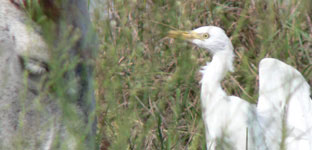 |
|
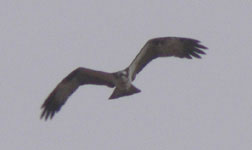 |
|
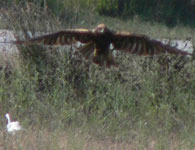 |
|
|
|
For a complete check list of this tour

|
|
|
|
|
|
|
|
|
|
|
|
|
|
|
|
|
|
|
|
|
|
|
|
|
|
|
|
|
|
|
|
|
|
|
|
|
|
|
|
|
|
|
|
|
|
|
|
|
|
|
26, 27 May 2006
|
|
Stephen Christopher
|
|
Lisa and Max Hopfl, England
|
|
|
Pyrenees, Lleida Steppes
|
|
|
|
|
|
|
|
|
|
|
|
|
|
|
|
|
|
|
|
|
|
"Thank you for a couple of days of very rewarding birding in beautiful places that we otherwise would not have seen, all thanks to your expertise... and such a delicious picnic. Perfecto!"
Lisa and Max, England
Firstly my thanks have to go to Michael Portillo, of all people, for making the Spanish wildlife documentary that inspired Max and Lisa to try once again, after having failed in both South Africa and Kenya, to see Lammergeiers. A google search and a couple of months later, we were watching a Red Kite circling above the car at a refreshment stop half way to THE PYRENEES.
About half way up the Greixer Valley we stopped again, at one of the most beautiful mountain meadows, not to mention places, that you’re ever likely to see. Made even more attractive by the prospect of spotting a Lammergeier, we waited content to take in the incredible views meanwhile and more than happy with the interval entertainment laid on by Ravens and one or two Golden Eagles. And then, bang on cue (it may just be me but they seem to appear later than other raptors, somewhere between 11.30 and 13.00) a single orange-bellied adult rafted and soared over the nearby ridge apparently in pursuit of the ever-increasing flocks of Griffon Vultures.
The Lammergeier, or Bearded Vulture, often capitalises on the hard work of its (in name only) cousins, sensibly allowing them to seek out a carcass, sitting back patiently whilst they consume the meat course and then, once they have departed, moving in for the leftovers, which with Griffon Vultures, will only ever consist of bones.
Our wait over, we made our way back down, via encounters with Blackcaps and Bonelli’s Warblers, to the car and, en route to the Coll de Pal, stopped off to watch the wonderful Rock Thrush.
At the tree-line meadow itself, which is always extremely productive, we took turns in picking out the various passerines flitting across our path. Black Redstart, Firecrest, Goldfinch, Linnet and Crossbill all drew our attention but the highlights were a very accommodating Red-backed Shrike and, as we crouched down to study an orchid that botanist Lisa had discovered, a stunning male Rock Bunting, chirping out a rather annoyed warning that we had stumbled a little too close to its nest site.
Serving as a timely alarm, we headed for the feeding station of hundreds of Red-billed and Alpine Choughs and arrived just in time to watch them use their specially adapted bills to systematically overturn individual rocks in search of the day’s final offerings. In what has almost become a ritual, as we drove along the track that divides their table, they lifted en masse and floated by the car windows, marshalling us far enough away before banking hard left and right, regrouping and flying off to roost.
We, save a short distraction by a small group of Alpine marmots drinking from a stream and with not nearly as much style, did likewise.
THE STEPPES OF LLEIDA. A single White Stork and a large group of Black Kite, circling over a mid-distant hillock, greeted us as Lisa, Max and I left the motorway and headed towards a section of Catalonia’s remaining Steppe habitat, an ever-decreasing area just to the south of Lleida.
As usual, Stone-curlew were the first of the Steppe birds to show their faces and, in this case, their huge eyes as they scuttled across a ploughed field, but it wasn’t long before we heard the familiar calls, and subsequently picked out a small flock of Pin-tailed Sandgrouse. Several more, seemingly invisible a few moments earlier, became apparent the very second the flock landed and we had plenty of time to stop the car, set up the scope and feast our eyes on their amazingly delicate and detailed plumage.
A short time later and Lesser Kestrel, Short-toed Lark and Red-legged Partridge were added to the list before, spotted amongst the Black Kites that had been dotted across the landscape ever since our arrival, was a surprise light-phase Booted Eagle, a little late to be roaming but appreciated all the more for it.
The short drive to a small wooded copse put up sprinklings of Calandra Lark, the car creating a domino effect of chinkling song-flights as it made its way across La Timoneda.
Crested and Thekla Larks obliged us with some identification practise before we did likewise with songs, picking out Melodious Warbler, Golden Oriole and, eventually after a fruitless hard search, one of the several Nightingales came to join us for our picnic lunch - as did the odd passing Red-billed Chough.
Hoopoe and Green Woodpecker (subspecies sharpei) showed well before we stumbled upon a funnel-entranced, pendulous nest and watched its owner, the wonderful Penduline Tit of course, making repeated visits. The highlight though by far was an accidentally flushed Red-necked Nightjar that landed just a few metres away and became the inadvertent subject of an amazing full-telescope view, whiskers and all. Memories like that just never fade.
En route to the next site, a Little Owl was caught skulking within a small disused bell tower whilst a bubbling flock of Bee-eaters did the opposite and happily drew our attention, skimming and whirling around a bank of last year’s nest-holes.
A roadside Roller welcomed us as we approached a rocky riverside spot close to Cogul, where the predictable, though none-the-less appreciated, Black Wheatear and Southern Grey Shrike were the highlight of the resident stock. And amongst the recent summer arrivals were Black-eared Wheatear, Woodchat Shrike and, close enough to note the spots on its underside, a Short-toed Eagle soaring directly above.
|
|
|
|
|
|
Alpine Chough
|
|
The Greixer Valley
|
|
Black-eared Wheatear
|
|
|
|
|
|
|
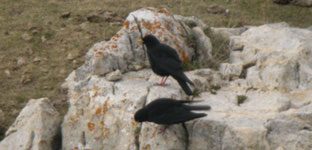 |
|
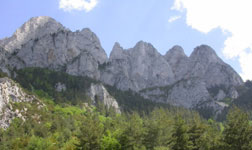 |
|
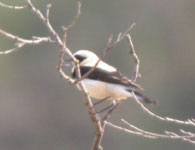 |
|
|
|
For a complete check list of this tour

|
|
|
|
|
|
|
|
|
|
|
|
|
|
|
|
|
|
|
|
|
|
|
|
|
|
|
|
|
|
|
|
|
|
|
|
|
Birdbox 3
|
|
|
|
|
|
|
|
|
|
|
|
|
|
6 - 13 May 2006
|
|
Jan Scheeres
|
|
Jan Scheeres and Jim Ellis, Wales
|
|
|
All Sites except Cap de Creus
|
|
|
|
|
|
|
|
|
|
|
|
|
|
|
|
|
|
|
|
|
|
"We had a superb week and appreciated your effort and skills very much."
"I would recommend anyone to contact Steve for a week or few days birding in the knowledge that his expertise and willingness to tailor the trip to individual needs will give a great experience."
On arrival at Barcelona airport Steve picked us up and we had a nice few hours birding at THE LLOBREGAT DELTA near the airport (see trip reports below for typical species, SC).
We woke up the next morning to the sound of Golden Orioles and Serins in the garden and after breakfast set off for THE EBRO DELTA.
Here we had magnificent and close views of all the herons except Bittern (photo of the stunning Little Bittern below), Caspian and Gull-billed Terns sitting beside Audouin's Gulls and Little and Temminck's Stint. There was a good deal of visible migration with numerous Willow Warblers in the Tamarisk bushes and even an exhausted Western Olivaceous Warbler (plus a rather stunning thunbergi Yellow Wagtail, my first for this site, SC). At the end of the day a stunning male Roller flew in and landed beside a Hoopoe.
On the second day we went to THE PYRENEES and saw Lammergeier and Griffon Vulture and large flocks of Alpine and Red-billed Chough circling around Alpine Marmots, whilst a Woodlark sang above us.
(and, appearing out of the clouds high up in the Greixer valley and gliding five metres above us, heading north towards France, an actual migrating Osprey, SC).
The following day we went to THE STEPPES OF LLEIDA and had stunning views of Pin-tailed Sandgrouse amongst Stone-curlews surrounded by flocks of Calandra Larks. There were numerous raptors to enjoy including large flocks of Black Kites and we stumbled on a roosting Red-necked Nightjar after watching a Little Bustard.
(A fantasic day. A pair of Egyptian Vultures were a much-desired lifer for Jim and, for Jan, a long-awaited Short-toed Eagle perched in a nearby tree, see above.
During the rest of the week we visited a number of excellent sites in THE AIGUAMOLLS DE L'EMPORDA and THE GARRAF MASSIF and saw some stunning birds in a wide variety of habitats. Steve’s raptor counting knowledge meant that he picked up most of the raptors and we also saw many of them perched which was a real bonus.
(plus several sightings of Bonelli's Eagle and two Red-rumped Swallows landing in a puddle next to the car, both in the Garraf. And, in Empordà, Honey Buzzards and summer-plumaged Knot, along with a poor Lesser Short-toed Lark chirping for nearly two hours on top of some recently threshed corn where its nest used to be.)
We ate out most nights in some excellent and reasonable Catalan restaurants in Sitges which is a beautiful sea side town.
The trips were planned daily according to our wishes and prevailing weather and Steve’s local knowledge and humour made it an excellent birding experience. We saw around 175 species during the week and we didn’t rush (Jim and myself have a combined age of 140!).
|
|
|
|
|
|
Pin-tailed Sandgrouse
|
|
Little Bittern
|
|
Griffon Vulture
|
|
|
|
|
|
|
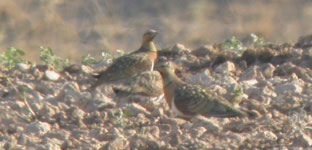 |
|
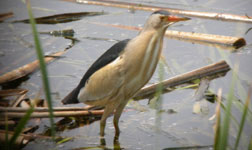 |
|
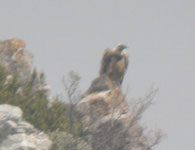 |
|
|
|
For a complete check list of this tour

|
|
|
|
|
|
|
|
|
|
|
|
|
|
|
|
|
|
|
|
|
|
|
|
|
|
|
|
|
|
|
|
|
|
|
|
|
BIRDBOX 2
|
|
|
|
|
|
|
|
|
|
|
|
|
|
29 April - 6 May 2006
|
|
Stephen Christopher
|
|
Declan Savage, Ireland
|
|
|
All Sites
|
|
|
|
|
|
|
|
|
|
|
|
|
|
|
|
|
|
|
|
|
|
"From the first few minutes at Llobregat I knew it would be a great trip. I've got so many fantastic memories of amazing birds and stunning landscapes... and the experience has definitely inspired me to plan a return trip"
"I've really benefitted from the time I've spent with you... your enthusiasm and breadth of experience are obvious"
"All the best with establishing your business. You're already off to a fantastic start - Amazing!"
Declan Savage, Ireland
After seven days of ‘dash and grab’ birding in an attempt to get as many species as possible, Declan’s instructions for the week ahead came as a welcome relief - strictly nice and easy! However, even after the usual short stop-off at THE LLOBREGAT DELTA before heading off to the villa to settle in, it was already clear we’d seen more than at the end of the previous Saturday. However, whether the increase from 50 to 75 species was because of our different approach, sitting and waiting in hides and strolling around slowly, would remain to be seen.
Little Bittern, Pochard and Reed Bunting, species difficult to see here without a little patience and all having avoided us last week, were already in the notebook and we had definitely picked out more species of wader as we both meticulously scanned the water’s edges. Deep black Spotted Redshank, already in summer plumage, and Ruff, catching up quickly, were the pick of the bunch but Wood Sandpiper and Greenshank were very accommodating, coming so close to the hide. However, even these were upstaged by the large water birds as Great White Egret, White Stork and some very showy Glossy Ibis added their names to the usual list of herons and Spoonbill.
The prehistoric-looking Collared Pratincoles, however, recently arrived and resting a few metres away, just tipped the stop-over Tawny Pipit, Pied Flycatcher and Northern Wheatear for the title of 'bird of the day'.
From the moment he stepped out of the car and laid eyes on the Vidala the previous day, I could see Declan’s expectations light up in his eyes. And if they were already satisfied, as he claimed, by the magic of the to-ing and fro-ing of the Llobregat Delta, they were nothing less than overwhelmed by the pair of Lammergeier we were now watching, marshalling high up in THE PYRENEES.
The very same spot proved typically generous with Golden Eagle, Short-toed Eagle and Griffon Vulture all passing through, Alpine Swift and Crag Martin skirting the mountain edge and two Black Woodpecker flitting from tree to tree, drumming their warnings to each other.
We eventually peeled ourselves away from our respective rock armchairs to take a short car-ride above the tree line, picking up Grey Wagtail and Nuthatch along the way and stopping off to enjoy the stunning Rock Thrush, a bird that looks as if someone had cut random pieces out of a bird magazine and pasted them together.
Once there, aside from being mesmerised by the family of Alpine Marmots at their usual watering hole, we lazed away amongst Common Crossbill, Ring Ouzel (subspecies alpestris) and, as usual gliding alongside the car, a seemingly begrudgingly mixed flock of Red-billed and Alpine Chough.
A fleeting visit from a Common Buzzard however, as we equally begrudgingly descended the mountain, ensured that the final word went to the family of the day, the raptors.
The following day, it seemed as if the word was out as, upon our arrival, Pin-tailed Sandgrouse, Great Spotted Cuckoo and Stone-Curlew did their best to compete for ‘day of the week’ on behalf of THE STEPPES OF LLEIDA, the latter showing itself right until the bitter end.
Black and Black-eared Wheatear, Red-rumped Swallow and both Woodchat and Southern Grey Shrikes all put in an appearance whilst our growing list of raptors expanded with Black and Red Kites and, perched on an old outbuilding, a lone male Lesser Kestrel.
Family of the day though went to the larks, with Calandra, Crested, Thekla, Short-toed and Skylark all presenting ample opportunity for identification practise.
Our visit to THE AIGUAMOLLS DE L'EMPORDA was timed to coincide with the peak of Red-throated Pipits passing through this north-eastern-most tip of Spain. The discovery of a small flock of summer-plumaged beauties at Vilaüt therefore and their subsequent ever-closer picks and prods through the mud provided much excitement and inspired and ensured our four-hour stay in just the one hide.
Other highlights here were Collared Pratincole, a quick stopover from a cinereocapilla Yellow Wagtail, a host of waders including summer-plumaged Dunlin and Curlew Sandpiper, freshly arrived Ortolan Bunting and an absolutely gob-smacking pair of Roller.
We eventually tore ourselves away and headed off to the main reserve where Penduline Tit, Spoonbill, Black Tern, and Hobby were amongst the highlights.
A cloudy start to our day in THE LLOBREGAT DELTA and GARRAF MASSIF may have, for many, loomed ominous but Declan just used it as an excuse to sit in a hide some more, where he happily waited to see what the rain would bring down. His reward was almost a full-set of waders including Temminck’s Stint, Avocet, Common Sandpiper and Black-tailed Godwit.
Interspersed with resident treats such as Night Heron, Common Waxbill and Purple Gallinule, other passage visitors included Audouin’s Gull and an invasion by a group of Whiskered Terns, sheltering their White-winged and Caspian cousins amongst their number.
We awed at their sky-skating acrobatics for the best part of an hour before they left and, taking their lead, we headed off to the Garraf. Here we added to the morning’s purring European Nightjar, with Turtle Dove, Rock Bunting, all three swifts including Pallid Swift, both Woodchat and Southern Grey Shrikes and singing Dartford and Melodious Warblers. A lone Peregrine Falcon continued our onslaught into the list of raptors.
|
|
|
|
|
|
Temminck's Stint
|
|
Red-throated Pipit
|
|
Rock Thrush
|
|
|
|
|
|
|
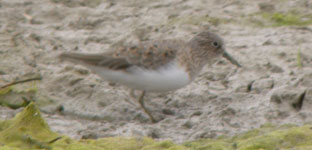 |
|
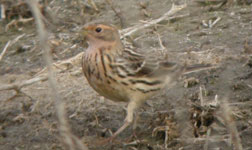 |
|
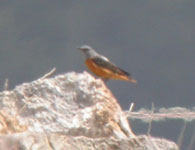 |
|
|
|
For a complete check list of this tour

|
|
|
|
|
|
|
|
|
|
|
|
|
|
|
|
|
|
|
Having had the fortune to observe already much of what THE EBRO DELTA had to offer at Catalonia’s two other wetland sites, I offered Declan the chance to change the programme but he declined, happy to ‘see them again’. Much better views of Audouin’s Gull, along with its Slender-billed cousin, Turnstone and Bar-tailed Godwit, and a naughty school of Little Bittern, seemingly playing tag in the reed beds all ensured he did not regret his decision.
Lesser Short-toed Lark completed the set for the week, whilst the competition for ‘family of the day’ began with Reed, Great Reed, Savi’s, Cetti’s and Fan-tailed Warblers all coming within ‘bins down’ distance. Common Whitethroat also showed up and, to cap it off, a perky migrant Spectacled Warbler appeared in the very same tamarisk bush where the Western Olivaceous Warbler and Wryneck had shown themselves the week before.
Today the terns had it though, with Gull-billed, Sandwich and Little greeting us throughout the day and an extended rain-induced lunch was spent sitting in the hide (where else?) at Riet Vell in the company of, for my ‘moment of the week’, Whiskered, Black and White-winged Terns all fishing not more than ten metres in front of us.
Yet again an easterly, llevante, wind was not forthcoming during the week but, for our final stop at THE CAP DE CREUS, at least conditions were a little more favourable than last week’s near blow out. We began with a first-light visit to a wooded valley I’d discovered and marked down as ‘potential’ during the winter. As the car doors opened we were immediately bathed in a wash of sound and we struggled for over an hour to keep track of the songs and calls of (and subsequently track down!) Golden Oriole, Nightingale, Woodlark, Redstart, Woodchat Shrike, both Spotted and Pied Flycatcher and, in no particular order, Melodious, Sardinian, Willow, Bonelli’s and, our target bird, the huge Orphean Warbler.
We were interrupted only (!) by a Goshawk sailing over the ridge to the east and, on the opposite side, a lone Common Buzzard picking a fight with an adult Bonelli’s Eagle!
Believe it or not, we did manage eventually to make our way to the Cap itself – entertained en route by Short-toed Eagle, Whinchat, Black-eared Wheatear, Red-rumped Swallow, Blue Rock Thrush, Crossbill and Rock, Cirl and Corn Buntings – where we arrived just in time to feast upon Balaeric Shearwaters and Northern Gannets weaving amongst the gull-trail behind the homeward bound fishing boats, accompanied occasionally by the more independent-minded Cory’s Shearwater.
Interestingly, wrapped up in the week’s events (even taking time out to go and see Barcelona play in the Nou Camp), we hadn’t always remembered to keep a daily check on our running species total but a final count showed no less than 194 species, including 16 raptors, and the verdict was in. At eleven more than last week’s hectic race, and with many more close-on experiences, ‘nice and easy’ definitely does it!
|
|
|
|
|
|
|
|
|
|
|
|
|
|
|
|
|
|
|
|
|
|
|
|
a
|
|
|
|
|
|
|
|
|
|
|
|
|
|
22 - 29 April 2006
|
|
Stephen Christopher
|
|
Dick Palmer and Myrna Deaton, U.S.A.
|
|
|
All Sites
|
|
|
|
|
|
|
|
|
|
|
|
|
|
|
|
|
|
|
|
|
|
Having been sent a wish list of 170 species by my clients, I began Catalan Bird Tours’ first-ever full week tour with as much nervousness as optimism. True, I’d planned meticulously, shed some species not present through distribution or time of year and the migration invasion was just getting into swing but, as the couple had visited Europe and its birds’ wintering grounds before, I couldn’t even rely on the ‘bankers’ such as bee-eater and the whole family of herons. No herons!? As I greeted them at the airport I felt the pressure building.
But, three hours and fifty species later, after a stop-off at THE LLOBREGAT DELTA on the way back to the villa, I was already relishing the challenge. It seemed that my nerves had caused a temporary loss of perspective and birds like Common Redshank, Yellow-legged Gull and Eurasian Coot had suddenly and joyfully began to bounce themselves off the target list. Spoonbill, Crested Lark and Zitting Cisticola quickly joined them and, with the sun shining and a sense of optimism returning, I dangerously (and only half-jokingly) revealed my theory that Catalonia grants birders a gift species right at the very end of each day. Right on cue, a migrant Pied Flycatcher, a starkly beautiful male and my first of the year, hovered and fixated on a doomed insect. Bonus.
THE STEPPES OF LLEIDA. Our first stop, south of the city, produced immediate sightings of Little Bustard, just ahead of the car, Lesser Kestrel, just over our heads, and Stone-curlew just about everywhere. Escorted on our way by Great Spotted Cuckoo, Calandra Lark, Rock Sparrow and a pair of nest-building Penduline Tits, we arrived at one of my favourite spots by the side of the River Set near Cogul in search of Black and Black-eared Wheatear, Blue Rock Thrush and Short-toed Eagle. We were not disappointed on any count, with the latter settling on a nearby rock after a slight skirmish with a Golden Eagle.
As the day neared its end I spotted a distant speck and confidently identified it as a Montagu’s Harrier. Spurred on by chuckles of American-accented incredulity, I declared that Catalonia still owed us our gift-bird of the day and ‘There’ll be a Montagu’s on the Aspa-Alfés link road'.
Now everyone knows that the first rule of guiding is that you never promise a bird. In fact, the only words my mum said when I told her I wouldn't see her very often as I was emigrating to become a bird guide in Spain were, ‘O.k. but never promise a bird.’
As we arrived and ventured into the vast expanse of recently planted farmland, I kid you not, but the most amazing male Montagu’s Harrier ghosted across our viewpath and quartered for an evening snack right in front of us. Wearing an exhilarated smile, I turned to my passengers to share the joke. Of course it was a fluke.
THE EBRO DELTA. Garganey, Red-crested Pochard, Audouin’s and Mediterranean Gulls, Reed, Great Reed, reed-top reeling Savi’s Warblers and seven species of heron kept us fully entertained but the highlight of the day - and arguably the week - was a flight-weary Western Olivaceous Warbler showing extremely well in a Tamarisk bush right next to a migrant Wryneck! Fantastic.
In fact, after adding Collared Pratincole, Short-toed Lark and Oystercatcher, the only serious omission for the day, given my clients’ pre-disposition towards gulls, was Slender-billed Gull. Odd considering how well they’re doing on the Ebro Delta so – without making any promises! - I suggested going back to a spot on the edge of La Tancada that we’d checked earlier. The two graceful adults we saw paddling there made up the 87th - and Catalonia’s parting gift - bird of the day and, once again, everyone went home happy.
Dick and Myrna were international tick-listers rather than bird watchers as such, prefering to seek, tick and move on. Their life target was 7500 species and so, the next day, after having dedicated only twenty minutes for Wallcreeper, Black Woodpecker and Lammergeier at a breathtaking spot in THE PYRENEES, Dick declared that ‘whilst we’re waiting here, they’re birds out there’ and we left to continue the quest.
Rock Bunting, tree top Ring Ouzel (subspecies alpestris) and flocks of Red-billed and Alpine Chough, mixing loosely but generally feeding on separate sides of the track, were amongst those subsequently added to the Griffon Vulture, Bonelli’s Warbler, and (White-throated) Dipper we’d already seen.
After Water Pipit, Dunnock and Black Redstart, Catalonia’s last-gasp gift bird was a glorious screaming Black Woodpecker, which brought up the 22nd lifer of the day, making 93 in all between them in the three-and-a-half days since we started. To my surprise, like a phantom pregnancy, I did find my self thoroughly caught up in their experience, but I couldn’t help wishing we’d stayed watching the Alpine Choughs floating alongside the car a little longer or wondering why we’d left the large family of Alpine Marmots at their drinking hole so soon.
|
|
|
|
|
|
Slender-billed Gull
|
|
Red-footed Falcon
|
|
Water Pipit
|
|
|
|
|
|
|
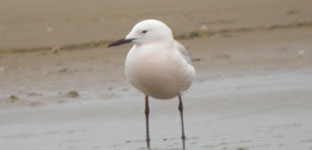 |
|
|
|
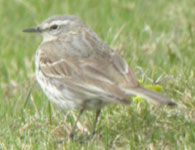 |
|
|
|
For a complete check list of this tour

|
|
|
|
|
|
|
|
|
|
|
|
|
|
|
|
|
|
|
It had been windy all week. But today, as we battled our way around THE LLOBREGAT DELTA and GARRAF MASSIF, it was very windy. Common Shelduck and Garden Warbler were ticked at Llobregat, whilst the six lifers in the Garraf were Pallid Swift, Tree Pipit, Stonechat, Dartford Warbler, Woodchat Shrike and, true to form, Spotless Starling as the day’s parting gift. Despite everything we still managed to see over 90 species today including a wonderful Osprey over the river.
At THE AIGUAMOLLS DE L'EMPORDA, the wind just got worse, its effects being apparent as it buffeted a light-phase Booted Eagle across the highway as we arrived. This same wind however brought and kept down a truly magical female Red-footed Falcon in a tree not ten metres from us (picture below); it resulted in a dozen or so summer-plumaged Red-throated Pipits resigning themselves to sticking around for the day and, when it finally calmed down in the late afternoon, released a sustained burst of surround-sound choral mating song, including a lone Melodious Warbler proclaiming itself ‘final gift of the day’. A great day.
All week I’d been awaiting a Llevante, or east wind, to bring in the shearwaters and other seabirds but it had not materialised so, on the final day, we headed for THE CAP DE CREUS.
The wind today was so ridiculous we couldn’t walk in it. So we sat. And for twenty minutes we watched an actual migrating Black Kite struggle in from the sea and miraculously and masterfully avoid being dashed against the rocks. When it finally landed we cheered. The wind was so bad today that we had to divert our route away from the cliffs for safety reasons. And banged into a small flock of Red-rumped Swallows taking refuge in a wind-sheltered hollow. Today the wind was so bad that we turned it to our advantage and, knowing the birds would seek shelter, searched behind an old farm building to find a flock of beautiful feeding Ortolan Buntings and in a small clump of cork oak in the hope of encountering the majestic Orphean Warbler. It was our final gift of the day and our final gift of the week.
Over the course of the week we had a collective total of 182 species, sighting nearly three-quarters of the birds actually possible from their target list. One of my clients saw 62 lifers, 12 above his expectations, and the other almost 100.
|
|
|
|
|
|
|
|
|
|
|
|
|
|
|
|
|
|
|
|
|
|
|
|
|
|
|
|
|
|
|
|
|
|

















